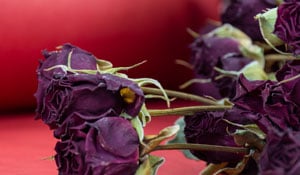Why do we give roses on Valentine's Day?

Customs and their origins can be fascinating, and the path of discovery, a historical rabbit warren. Over many centuries, the root of a custom we celebrate today often bears little resemblance to its current form.
Take Saint Valentine's Day: On February 14th each year, swathes of the world's population turn to ideas of love and give red roses as a token of that love.

Why? Good question when we look back at who Valentine may have been. There are conflicting accounts of who the original St Valentine actually was. Current estimates suggest an excess of 10,000 saints, it is believed there are over 30 who were named Valentine, and of those, 2 may be contenders for the Valentine.
Some readers may be aware that Valentine was martyred, but that doesn't help us narrow down our candidate. Marcus Aurelius Claudius Gothicus, or Claudius II of Rome, was responsible for the demise of these Valentines who were both Christian and found guilty of performing miracles. It is also thought that each Valentine was put to death on February 14th (albeit in different years). Let's just guess it was most likely one of these poor fellows!
But why do we associate a celebration of love with the execution of a Christian? It's possible that ancient Rome is at fault here too. Pagan festivals and feasts were celebrated most days of the year, and on February 15th, Romans celebrated the feast of Lupercalia. According to the Encyclopaedia Brittanica, the origins of Lupercalia aren't fully understood, but it involved the ritual sacrifice of goats, fertility rites, marriage lotteries, and feasting. By the 5th century C.E., in the now Christian Rome, Pope Gelasius banned participation in the festival, and there was a belief that Valentine's day was squeezed in on the 14th at this time, although historians now think it was later on.
It's thought that the union of St Valentine's day and romance didn't occur until the 14th century. Valentine's messages began to appear in the 16th century, and as the printing press revolutionised the world, printed cards were being sent as tokens by the 18th century. The Victorian age is when commercialised Valentine's cards really took off, and harking back to Pagan Rome, emblems such as Cupid became ubiquitous.
So why flowers, and why roses in particular? In the Victorian era, women were expected to remain demure and know their place. Should they wish to communicate about things (and to people) that didn't fit with this expectation, it needed to be done discreetly. The easiest way to do this, without causing scandal, was in code. Taking inspiration from Lady Mary Wortley Montagu's 18th-century communications using the language of flowers, (a corruption of the Turkish practice of coding messages with words that rhyme with objects, or sélam) a seemingly innocent embroidered work could be gifted, and a coded message sent. In the 19th century, Charlotte de Latour wrote Langage des fleurs, a dictionary for the language of flowers, detailing different flower species and their hidden meanings. A young lady's guide to coding with flowers, if you will!
And what of the meaning of the rose within this text? “Who that ever could sing has not sung the Rose! The poets have not exaggerated its beauty, or completed its panegyric... Nature seems to have exhausted all her skill in the freshness, the beauty of form, the fragrance, the delicate colour, and the gracefulness which she has bestowed upon the Rose...” wrote de Latour.
From this point on, spurred by romance and chivalrous renaissance, the Victorian's reverence for the rose grew and grew, with sales of roses skyrocketing, and new varieties being developed in the UK, Europe, and the US to satisfy the demand. The American Beauty cultivar was even shipped from the northeast of the United States to Queen Victoria, such was its royal approval. In Victoria's time, it was so expensive that it was called the millionaire's rose, but now it's one of the more common varieties that is given as a love token on Valentine's day.
Has this piqued your interest in roses? We may not offer fresh blooms, but we can delight you with beautiful, delicate, dried roses, in a variety of colours. They last for such a long time if well looked after. Head over to our shop to see more.
Follow us on social media!
References
Brooks, M., 2008. Silent Needles, Speaking Flowers: The Language of Flowers as a Tool for Communication in Women’s Embroidery in Victorian Britain. [ebook] Textile Society of America. Available at: <https://digitalcommons.unl.edu/cgi/viewcontent.cgi?referer=&httpsredir=1&article=1283&context=tsaconf> [Accessed 7 February 2022].
Combs, S., 2020. Valentine's Day wasn't always about love. [online] National Geographic. Available at: <https://www.nationalgeographic.com/culture/article/saint-st-valentines-day> [Accessed 7 February 2022].
Greenspan, R., 2020. Giving Roses for Valentine’s Day? Here’s How the Flower Came to Symbolize Love. [online] Time. Available at: <https://time.com/5519476/roses-symbol-love-valentines-day/> [Accessed 7 February 2022].
Editors Encyclopaedia Britannica, 2021. Valentine’s Day | Definition, History, & Traditions. [online] Encyclopedia Britannica. Available at: <https://www.britannica.com/topic/Valentines-Day> [Accessed 7 February 2022].
Editors Encylopaedia Britannica, n.d. Lupercalia | Description, Meaning, Traditions, Date, & Facts. [online] Encyclopedia Britannica. Available at: <https://www.britannica.com/topic/Lupercalia> [Accessed 7 February 2022].

